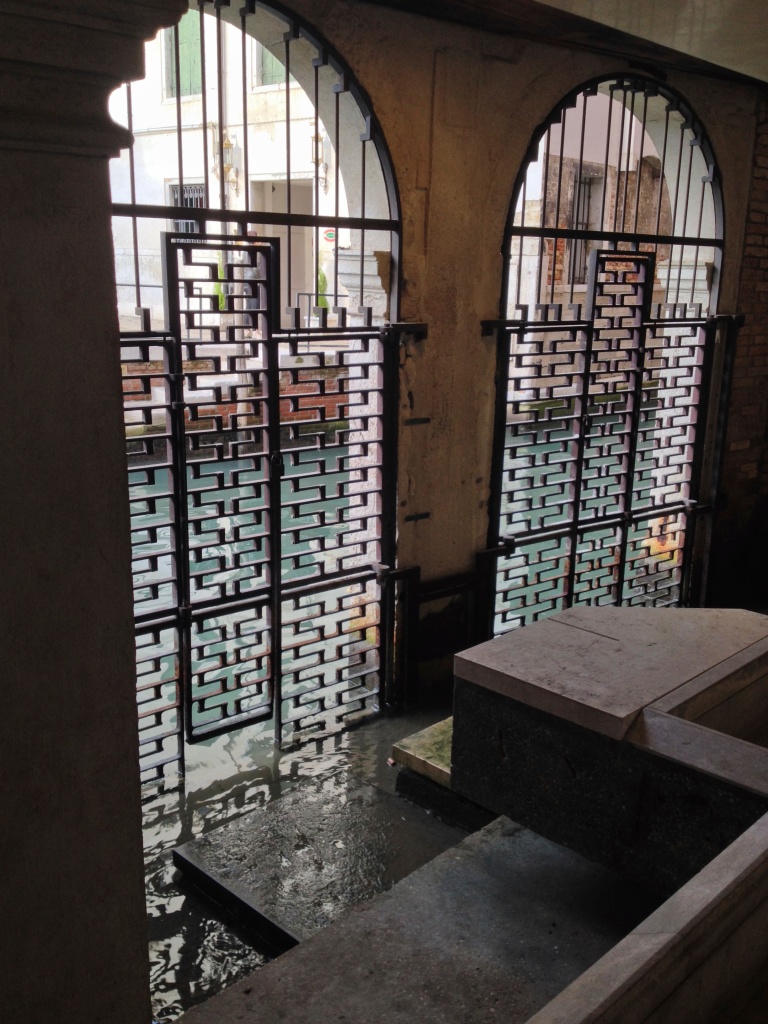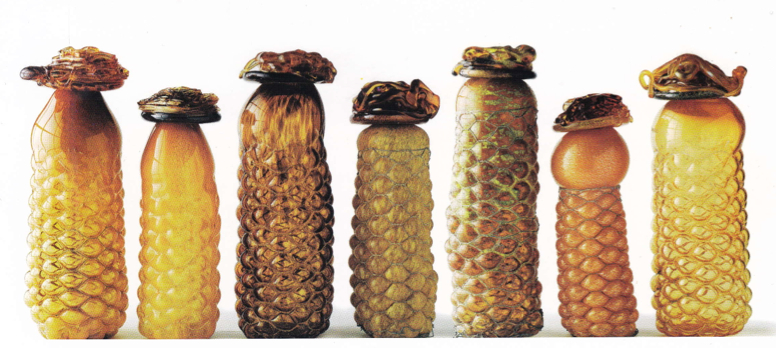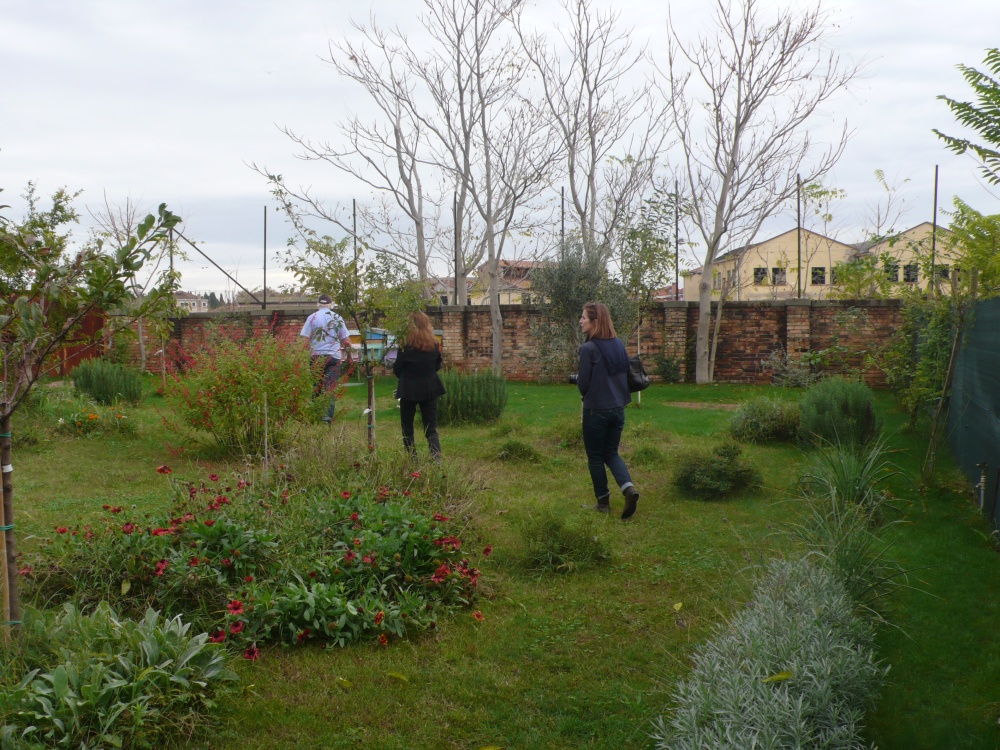VISIT TO AN ARTIST’S ORCHARD GARDEN ON MURANO AND A SCARPA GARDEN IN VENICE
 Dinner in Vini da Arturo where I ate pasta with a very delicious sauce made from raddichio da Treviso which had been cooked for five hours (a clove of garlic, half an onion , half a cup of olive oil, basil and parsley and a kilo of raddichio – add water every ten minutes, add half a cup of cream and parmesan before serving, since you ask). We got talking to New York artist, Judi Harvest http://www.judiharvest.com , who invited us to meet her the next day at her Biennale show – Denatured – which takes the form of a honey bee garden on the island of Murano with beehives painted the colours of the fishermens’ houses on Burano
Dinner in Vini da Arturo where I ate pasta with a very delicious sauce made from raddichio da Treviso which had been cooked for five hours (a clove of garlic, half an onion , half a cup of olive oil, basil and parsley and a kilo of raddichio – add water every ten minutes, add half a cup of cream and parmesan before serving, since you ask). We got talking to New York artist, Judi Harvest http://www.judiharvest.com , who invited us to meet her the next day at her Biennale show – Denatured – which takes the form of a honey bee garden on the island of Murano with beehives painted the colours of the fishermens’ houses on Burano
image courtesy of ‘Denatured Honeybees+Murano’catalogue
and an exhibition of glass honey vessels and paintings at the elegant Scola die Batioro e Tiraoro – the eighteenth century building on the Grand Canal that was once the headquarters of the city’s goldworkers.  Judi worked with master glassblower Giorgio Giuman and his family at the Linea Arianna factory on Murano to create the beautiful abstracted glass vessels in gorgeous, glowing honey-inspired colours – from olive to deep amber to a clear lavender. The vessels are a celebration of the sensuous, viscous quality of both honey and molten glass and the use of found chicken wire as a framing device, with the blown glass bulging stickily through, perfectly echoes the rhythmical, hexagonal structure of honeycomb.
Judi worked with master glassblower Giorgio Giuman and his family at the Linea Arianna factory on Murano to create the beautiful abstracted glass vessels in gorgeous, glowing honey-inspired colours – from olive to deep amber to a clear lavender. The vessels are a celebration of the sensuous, viscous quality of both honey and molten glass and the use of found chicken wire as a framing device, with the blown glass bulging stickily through, perfectly echoes the rhythmical, hexagonal structure of honeycomb.
image courtesy of ‘Denatured Honeybees+Murano’
At the heart of the exhibition, suspended from the ceiling with the grandeur and glittering allure of the finest Venetian chandelier, is ‘Monumental Hive’ – made from porcelain, beeswax, goldleaf and resin and which took six months to construct.
image courtesy of ‘Denatured honeybees + Murano’ cataloge.
As we ride in the water taxi over to the factory, Judi explains how the exhibition was conceived. She had become increasingly aware of both the global environmental crisis in the dwindling honey bee population and the saddening local decline of handmade glassmaking in Murano – a seven hundred year old tradition being increasingly and aggressively replaced by cheap imports from China and Eastern Europe.
In New York, to find out more about bees, Judi set up beehives on her studio roof terrace (keeping bees has, amazingly, only been legal in New York City since 2010) and became involved with Bees Without Borders ( http://www.bestbees.com) a brilliant small charity whose aim is to reduce poverty by teaching beekeeping skills around the world.
In Venice, as she set about making her work in glass for her exhibition, she also took on the extraordinary – and pretty much single handed – task of making a real, durable bee friendly garden in the neglected grounds of the factory on Murano.
It was brilliant to visit the garden with her. We spent time in the factory first – a wonderful place with the raw, ramshackle, treasure trove quality of the best studios and workshops –

 and then we entered the almost story book world of the walled garden with the brightly painted beehives as the focal point and fruit trees – pomegranate, peach, pear, cherry, apple and quince – encircled with cushions of lavender and sage.
and then we entered the almost story book world of the walled garden with the brightly painted beehives as the focal point and fruit trees – pomegranate, peach, pear, cherry, apple and quince – encircled with cushions of lavender and sage.


 This tranquil space does not betray the dogged hard graft it took to make it. Once the ground was cleared of rubbish and broken glass, everything – soil, turf, trees, plants, bee hives – had to be sourced somehow from the nearest possible point, brought in by freight boat and installed in the heavy rains and aqua alta of early spring 2013.
This tranquil space does not betray the dogged hard graft it took to make it. Once the ground was cleared of rubbish and broken glass, everything – soil, turf, trees, plants, bee hives – had to be sourced somehow from the nearest possible point, brought in by freight boat and installed in the heavy rains and aqua alta of early spring 2013.
But the impact of the garden has been significant beyond the scope of the exhibition – it has had a powerful effect of the pride and self esteem of the Giuman family – finally a place to go when there is a chance to take a break from the intense heat and dusty concentration of glass blowing. Giorgio’s daughter made the sweet threshold sign ” il giardino delle api” out of glass beads. Already the history of the garden is taking off by itself – and honey and fruit will be harvested for years to come.

We have lunch in a great workers’ cafe/restaurant, Trattoria Bar Serenella dal Coco just next door to both the glass factory and the Serenella vaporetto stop. Surely the cheapest spaghetti vongole you will find in Venice?
In the afternoon we take the vaporetto to the island of Torcello to see the cathedral of Santa Maria Dell’ Assunta. The cathedral was built in the Seventh Century and is most famous for its Byzantine mosaics.  image by Remi Mathis via Wikipedia Commons
image by Remi Mathis via Wikipedia Commons
As well as the gorgeous elongated simplicity of the Madonna and Child on a gold ground which fills the entire curve of the apse, I am captivated first by the pale zig zag marble of the walls and then the marble floor.
A bold, inventive, delicate patchwork of ochre, russet, black, green, grey and white. A celebration of whatever could be sourced over the years.
Later in the afternoon we enjoy an elegant, 20th Century interpretation of the same materials at the Fondazione Querini Stampalia. The ground floor interior and garden of this sixteenth century palazzo now art gallery were brilliantly redesigned by Venetian Architect Carlo Stampa in the early sixties.
I am utterly charmed by the incredible quality and detail of his work here. I love the spare geometric ironwork of the pair of gates which lead – tantalisingly – straight into the milky water of the canal,

and the graceful double row of precious and semi precious tiles set into a speckled concrete wall.

 The floating emerald discs of water lily leaves provide a glossy rhythm to the rill
The floating emerald discs of water lily leaves provide a glossy rhythm to the rill
 and the band of stainless steel circles which line the wooden frame of the pond and the patterns of tiles and stepping stones cut into the lawn add further delightful layers of texture.
and the band of stainless steel circles which line the wooden frame of the pond and the patterns of tiles and stepping stones cut into the lawn add further delightful layers of texture.
 We are feeling the city’s charm badly. Flashes of red everywhere. Deep red Virginia creeper drapes itself knowingly over an austere castellated wall.
We are feeling the city’s charm badly. Flashes of red everywhere. Deep red Virginia creeper drapes itself knowingly over an austere castellated wall.
One of the city’s red painted benches waits confidently in a crumbling square.
 Partially lowered red canvas blinds provide a warming glow to the cool, shiny damp of the fishmarket.
Partially lowered red canvas blinds provide a warming glow to the cool, shiny damp of the fishmarket.
 An avenue of eighty year old Pittospurum, shaped into lush and portly trees, anchors the garden of a crumbling private palazzo
An avenue of eighty year old Pittospurum, shaped into lush and portly trees, anchors the garden of a crumbling private palazzo
Even the museum posters plastered onto corrugated iron seem to be a symbol of the beautiful and endlessly creative city which is always the same but always slightly changing.















I have been waiting to see, feel and read about this amazing honey bee exhibition — and I was not disappointed!! Beautiful photographs and — of course — flowing text. More please! 🙂
Thanks for all this. So glad you enjoyed it.
Dear Non,
I enjoy reading your beautiful text and images of Venice and my exhibition. It makes me homesick. It was lovely to meet you in Venice and spend time together in Murano. I am happy to report the Honeybees and Honey Garden have doubled in size in their first year! I hope we meet again very soon. 2 recent press articles have come out, including 1 in the New York Times about the project. I will send it. Keep up your beautiful work.
Best wishes,
Judi Harvest
Hi Judy – fantastic to hear from you and wonderful to know that your Honey Bee Garden on Murano is doing so well. I hope to go back to Venice again this year – it is the most addictive place. Spring in the UK is pretty addictive too at the moment. Tomorrow I am visiting one of my favourite gardens, Great Dixter. I would love to take you there if you come over to the UK. I am 100% sure to be visiting New York this time next year. I be in touch on this! With very warm wishes Non
Pingback: Building a Beehive on Your Own – Three Vital Aspects to Consider | Langstroth's Hive
Pingback: AN ENGLISH GARDENER IN NEW YORK: PART II | The Dahlia Papers
Hi Judy – we loved meeting Andrew Cote at his multicoloured stand at Union Square Farmers Market. Thanks so much for suggesting we did. As you can see I adored the High Line too. Hope your time and exhibition in Venice going extremely well. Very best wishes Nonx